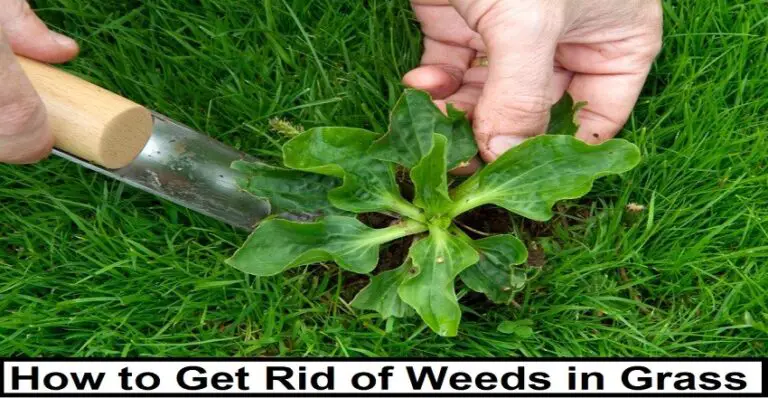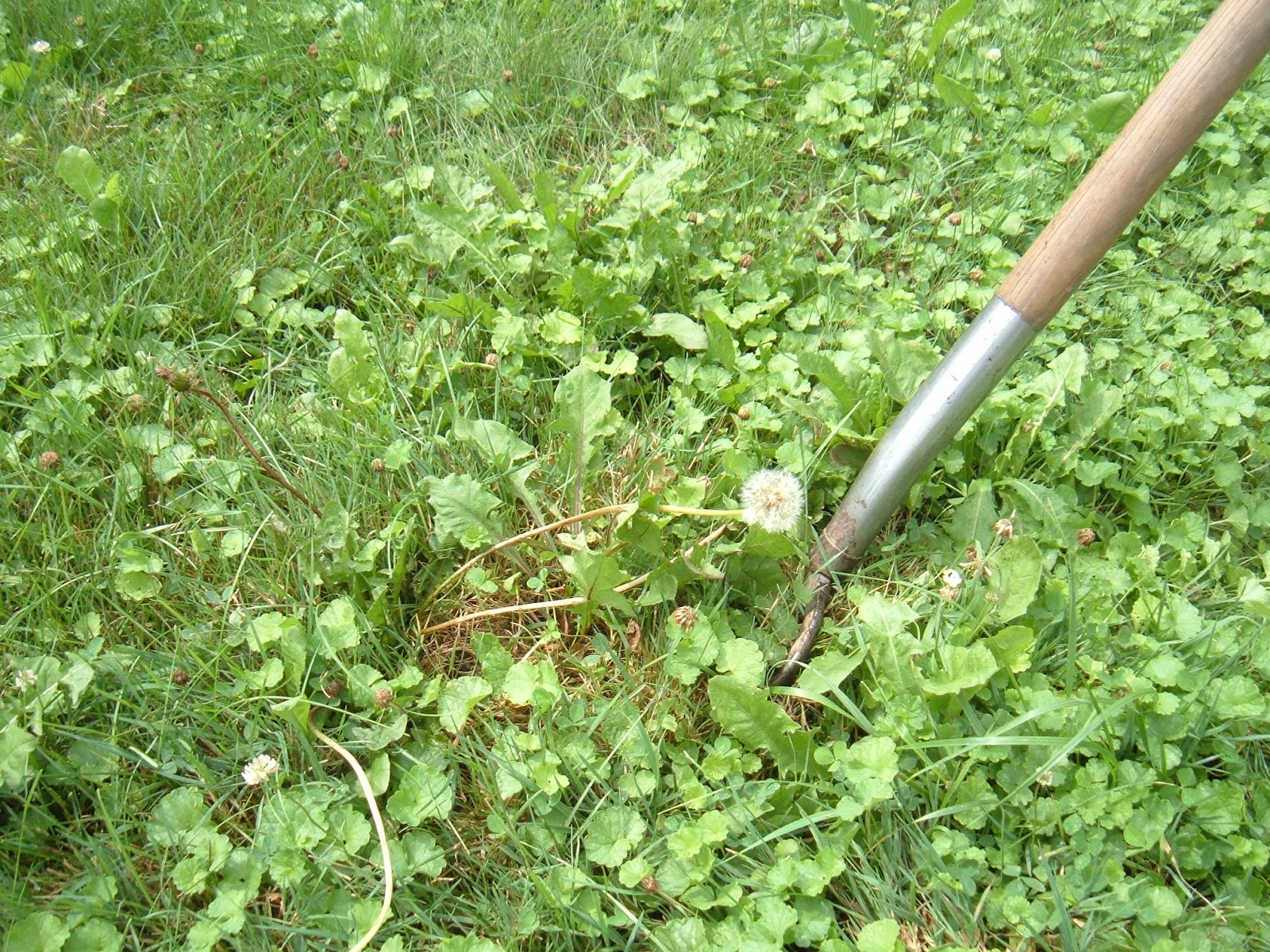Understanding How Weed & Feed Products Work
Lawn and garden products known as “weed & feeds” get their name from two main components: herbicides that kill existing lawn weeds and fertilizers that feed lawn grass. Unlike crabgrass preventers, which contain “pre-emergent” herbicides that work against germinating weed seeds, most weed & feed products contain “post-emergent” herbicides, which focus on weeds that are actively growing in established lawns.
Weed & feeds vary in the common lawn weeds they target and the herbicides and plant nutrients they include, so it’s important to read your product label thoroughly. Common weed & feed products generally rely on “selective” herbicides that target specific broadleaf weeds, so lawn grasses stay unharmed. Some weed & feed products are most effective on weed parts above ground. Others kill top growth and roots, so weeds can’t spring back and repopulate your turf.
How To Control Weeds In A Newly Seeded Lawn
However, you can get rid of these weeds just as fast as they have appeared.The important thing to remember when new weeds appear in your newly sown lawn is not to act hastily do not apply a Feed, Weed and Moss Killer type product of any kind on a newly sown lawn.
Although this can be frustrating and we can appreciate that a quick solution will be desired, the good news about these types of weeds is that they are largely shallow rooting and should come out with the first mow at the 6-8 week mark after sowing. If they dont, they should be easy to pull out of the turf.
If you find that the weeds are recurring past the 6-8-week mark, you may wish to consider using a selective herbicide to spot spray your weeds. Some weed killers such as glyphosate kill more than just weeds, so it is important to not apply these as if they are not done precisely, they can kill your grass. Shop bought selective weed killers will recommend when to apply their product and how often and you should read the instructions thoroughly and adhere to them.
In short, here’s what you should do if you encounter weeds in your newly seeded lawn:
How To Kill Weeds In Lawns: A Healthy Lawn Is The Best Defense
Weeds are opportunistic. They spot a lawn that lacks nutrients, isnt draining properly, is thin and stressed and they attack without hesitation.
A healthy lawn is one that is mowed to a 3- to 4-inch height, watered appropriately and has the proper balance of nutrients through regular fertilization. Annual aeration can also help the lawn breath. Follow that up with overseeding and bare spots will disappear.
Your mission is to create an optimum environment for grass to grow over weeds. A thick, thriving lawn has the power to repel weeds.
Read Also: How Much Does It Cost To Have Your Lawn Rolled
How To Get Rid Of Weeds Without Killing Grass
Its exciting when plants you have nurtured begin to grow in your yard. Green, lush grass. Colorful flower beds. A thriving vegetable garden. UUnfortunately, when it comes to caring for our lawns, theres always one thing you can count on: youre going to have to deal with lawn weeds. One topic thats always in season is how to kill weeds, not grass and how to do it naturally. If you make a lawn weed control plan in advance and attack the problem early in the season, you can make less work for yourself over time. Below, our experts identify some common weeds in the south and what you can do to get rid of them naturally without killing grass or plants.
What Are Lawn Weeds

Lawn weeds are invasive broadleaf plants or grassy plants that grow in lawns. The weedy plants spoil the appearance of a lush lawn and affect grass growth. Some plants like dandelions are perennial weeds that come back year after year. Annual weeds like crabgrass die off each season and regrow from seed.
Don’t Miss: Does Scotts Lawn Fertilizer Expire
Broadleaf Weed Control In Lawns
Vinegar and salt is one homemade dandelion killer that wont kill grass if you are careful when spraying it. Always spray the weeds directly never spray any of the greens, unless they are broadleaf grasses you are looking to kill.
DIY Vinegar Broadleaf Killer Recipe
- 1 ¼ cups of salt
- 1-gallon white vinegar
To use this easy DIY brush and weed killer, use a clean spray bottle and combine the vinegar with the salt. Close the spray bottle and set the sprayer to stream rather than spray.
For killing weeds with vinegar, squirt the heads of the dandelions or other weeds directly without spraying the surrounding grass and plants you want to keep. Avoid spraying this mixture into the soil, as it can cause the ground to go sterile for up to two years.
How To Get Rid Of Crabgrass
What it looks like: This common weed looks like yard grass but grows horizontally and has flatter, wider leaves that extend from its center. It also has flower heads that resemble spikes.
Where it typically grows: Crabgrass grows anywhere bare soil presents itself and is most prominent in late summer.
How it spreads: Crabgrass multiplies through its seeds and pieces of its stems that can sprout new roots.
Best ways to get rid of it: A dual-acting crabgrass killer like Roundup Ready-to-Use Extended Control Weed & Grass Killer Plus Weed Preventer kills existing crabgrass and prevents new seeds from germinating in the soil. For more details and tips, check out this comprehensive guide to crabgrass removal.
Don’t Miss: Homemade Creeping Charlie Killer
How To Kill Broadleaf Weeds On Your Lawn
- Identify what weed is invading your lawn, how big of an issue it is, then equip yourself with a broadleaf weed killer like msm turf herbicide to target your broadleaf weed problem.
- You may be tempted to go cheap and buy a general broadleaf weed killer from a box store but you may be setting yourself up for disappointment. Our herbicides have a large percentage of active ingredient in high quality concentrates.
- Mixing a small dosage of broadleaf weed killer with water will yield a lot more product and will last you for a whole lot more applications than one watered down generic weed killer container. You’ll save a ton of money over time.
What Does Nutsedge Look Like:
Nutsedge appears in the summer and is easily distinguishable as it grows faster & taller than the grass in the lawn. When Nutsedge is left growing, yellow flowers will sprout from the weed. Pro Tip: Do not pull Nutsedge from your lawn, as any roots left in the soil can cause new weeds to sprout and grow.
You May Like: Violet Weeds
How To Get Rid Of Dandelions
What it looks like: This common perennial weed is easy to identify with its long, hairy stem and bright yellow circular flower with countless petals. When the flower matures, it turns into a circular white puff full of tiny seeds.
Where it typically grows: Dandelions emerge in the early spring and can remain in the yard as long as the weather is warm.
How it spreads: Its iconic puffball seeds come off easily and blow away. The wind carries them to new destinations where they take seed and grow.
Best ways to get rid of it: People who want to know how to kill dandelions will find an excellent solution in a broadleaf weed killer like Ortho Weed B Gon Weed Killer.
Pry Weeds From Paving With A Weeder
The Telescoping Crack Weeder from Lee Valley Tools removes grass and other weeds from crevices in patios and walkways. The L-shaped stainless-steel blade fits between bricks and other pavers to reach and scrape pesky plants. The aluminum handle adjusts from 28 to 45 in., which means you can weed kneeling or standing.
Also Check: How To Get Rid Of Corn Speedwell In Lawn
How To Get Rid Of Broadleaf Weeds In Your Yard
Broadleaf weeds are an unwelcome guest in any outdoor space. And its no wonder why: these plantsthe likes of which include dandelions and chickweedcan compete with lawns for sunlight, water, air and nutrients as well as prey upon weak areas of the lawn and invite in pests and diseases.
While preventative measures are the best way to control broadleaf weeds that can emerge in the springtime , many homeowners find themselves working against an existing population. If youre in a similar scenario with your Ohio lawn, youll be happy to learn there are ways to put these commonly spotted weeds to rest and improve the overall health of your lawn.
As well showcase here, the course of action you take will depend on the size and type of broadleaf weed population as well as how receptive the weeds are to treatment.
Common Lawn Weeds And How To Get Rid Of Them

Even the best-tended lawns come under attack from common weeds. Weed seeds float in on the wind, creeping weeds claim more territory, and weeds you thought you pulled quietly continue to grow. How well your lawn copes with the onslaught depends on the weeds involved, the response you choose and your lawns overall health. Understanding common lawn weeds and the options available to fight them can help you successfully combat the invasion.
To help simplify weed defense, weve charted 10 common lawn weeds, including their characteristics, type and how they spread, and most importantly- how to eliminate them. Weeds, like ornamental garden plants, can be annuals or perennials. Annual weeds, such as crabgrass, complete their entire life cycle in a single growing season, and then die, leaving seeds behind to continue the legacy. Perennial weeds, such as dandelions, come back year after year from their roots, and distribute new seeds to boot. Weeds can also be grass-like, broadleaf or sedge. Choosing the right weed control product requires understanding the weed you want to fight and its stage of growth. Pre-emergent weed controls, sometime called preventers, work to keep weed seeds from germinating and developing. Post-emergent weed controls fight weeds that have already germinated and emerged from the soil.
Don’t Miss: Where Are Cub Cadet Tractors Made
Identify And Treat Other Weed Types
After waiting for the second 2 week period after the second herbicide application, you then look to identify the remaining weed types.
If the remaining weeds are small in numbers, then the best option may be to spend a little time in pulling or digging them out.
However, if there are still a large number of unaffected and healthy weeds in the lawn, then it could be prudent to purchase a specific herbicide to kill them.
If youre well versed with weed types or are up for a bit of online research, this can be a very simple task. Otherwise, it would be wise to pull out some of the remaining weeds and take them to your local Nursery for identification, and a suitable weed killer purchased.
It is important to always identify weeds properly, buy the correct herbicide and always apply at the manufacturers specifications.
Managing Weeds In Fescue Lawns
Factsheet | HGIC 2309 | Nov 4, 2019 | |
Tall fescue, Festuca arundinacea, is a popular turfgrass grown in the mountains and upper piedmont areas of South Carolina. To keep it looking its best, weeds should be controlled through an integrated approach. This involves knowledge of weed characteristics and the cultural requirements of the turf.
You May Like: What Kills Wild Violets
What Is The Best Time To Spray Broadleaf Weeds
The best time to treat your lawn and get rid of broadleaf weeds is from mid-September to early November.
If your turf has perennial weeds, start spraying the chemical in the fall. During the fall, the plants begin to transport food from their foliage to the roots as they prepare for winter.
Once you spray the chemical in the fall, the foliage will absorb the herbicide and transport them to the root. As a result, it will destroy the weeds, along with the carbohydrates.
Avoid applying the weed killer in the spring because it is less effective.
Different Ways To Control Weeds
For weed and pest control, make a spray solution with one-half gallon of vinegar, one tablespoon dish soap, 15 drops of clove oil, and 15 drops of peppermint oil. The clove oil kills the cellular membranes of the plants, while the peppermint oil works to drive unwanted pests away.
Mixing a quart of water and two tablespoons of rubbing alcohol works to kill dandelions and a few other weeds. Spray the weed, making sure all the leaves are wet. The rubbing alcohol pulls out moisture, which kills the plant. Always apply on a sunny day and avoid spraying wanted vegetation.
Boiling water poured directly on weeds kills them through scalding. Always pour boiling water carefully, so as not to splash it on yourself or surrounding plants. For extra weed-killing power, sprinkle wet weeds with rock or table salt.
Recommended Reading: How To Bid Lawn Care Jobs
Mowing Properly And Regularly
Your grass should be cut every week during the Spring, and at least every ten days during the summer. Mulching the grass back into the lawn helps spread grass seed and increase turf thickness. Your blades need to be sharpened yearly and never cut the grass more than 1/3 of its total length. Every time your mow your lawn, you also mow the weeds which takes them out of the picture of a couple days, but dont forget that the roots are still alive and well and they will try to grow back.
Blog: How To Kill Weeds Without Killing Your Lawn
Having a beautiful lawn comes at a price. Either you spend a moderate amount of money and spend a good amount of time doing it yourself, or you hire a company to handle it for about $350 per season. Its a question of how much time are you willing to invest in it, can you properly do it or do you need help, and is it something you enjoy doing? Regardless of if you do it yourself or hire some help, your goal is the same: Have a beautiful green lawn with no weeds. Ensuring a weed free lawn comes down to having a strategy for prevention, as well as removal for when they breach your lawn defenses. This article will talk about strategies on how to do both so that you can maximize your chances of success. A weed free lawn, is a stress free summer for many homeowners each season.
Recommended Reading: How To Control Wild Violets
Yellow Nutsedge Control In Home Lawns
Yellow Nutsedge is a common weed found in many home lawns in New Jersey and Delaware. Aside from detracting from the aesthetic quality of the turf, yellow nutsedge can compete with desired turfgrasses for water, nutrients, and sunlight. If allowed to grow, yellow nutsedge can quickly spread to infest large areas of the home lawn.
Kill Weeds In Lawns: Begin With The Basics

If you have a yard, you have weeds. They may lurk in the lawn, thrive under a shrub or flourish in flowerbeds, making weed control a constant battle. It requires patience, persistence and knowledge of both types of weeds and the weapons you have to eradicate them.
What Is A Weed?
A weed is a plant that’s growing where it’s not wanted. Weeds aren’t something you plant intentionally they just appear. Often they grow vigorously, outpacing and overrunning desirable plants. There are several types of weeds:
Annual Weed: Completes its life cycle from germination to setting seed in one growing season some annual weeds complete their life cycles in a matter of weeks, producing several generations in a single year.
Fact: Annual weed seeds can lie dormant in soil from 4-40 years.
Examples: Chickweed, Crabgrass, Lamb’s-Quarters, Annual bluegrass
Perennial Weed: Lives for two or more years plants grow as long as conditions are favorable and frequently die back to soil level with hard frost new growth emerges at the start of the growing season, originating from roots or stem remains in warmer regions, some perennial weeds can be green year-round.
Fact: Perennial weeds spread by various means, including seed, stems that root as they creep along or pieces of root.
Examples: Creeping Charlie, Curly Dock, Dandelion, Plantain
Broadleaf Weed: Leaves are broad and flat .
Examples: Chickweed, Clover, Dandelion, Henbit
All About Lawn Herbicides
Timing
Recommended Reading: How To Kill Wild Violet Weeds In Lawn
Lawn Care & Maintenance
If you dont take good care of your turf, its not unusual to see weeds take over your entire lawn.
The most important thing you can do to keep weeds out of your lawn is to make sure it grows in perfect health.
A thick, lush lawn leaves less opportunity for weeds to establish themselves. And crowds out any that start to grow.
Here are some lawn maintenance tips that help to keep weeds away:
How To Get Rid Of Clover
What it looks like: A clover weed is a low-growing plant that has sets of three leaflets emerging from its many stems. The flowers are usually white and circular with multiple long, thin petals.
Where it typically grows: There are many species of clover that thrive in different conditions like full sun, shade, dry soil, or wet soil.
How it spreads: Clovers reproduce through their seeds and through nodes on theirstems.
Best ways to get rid of it: A great clover killer is Bonide Chickweed, Clover, and Oxalis Weed Killer, which is a ready-to-use formula.
Recommended Reading: What Do Lawn Care Companies Do In The Winter